Thursday, March 30, 2006
My Thoughts on Anime : An Interview
In 2004, I was contacted by a high school student who was doing a research project on anime. As part of that project, she had to interview someone who was formally studying anime (and/or related topics). She found me through the Anime and Manga Research Circle and interviewed me over email. The questions were fairly general but fun to answer, and the interview allowed me to express thoughts concretely that were previously just floating around in my head.
Here is the interview (republished with permission):
1) What do you like about anime and manga?
I like many different things. First off, I like the stories and the art. I think animation allows one to do things in terms of exposition and special effects that you can't easily do in live action films. In my opinion, Japanese animation is currently doing a better job (than American animation) at expressing the full potential of animated stories.
There are so many anime production companies in Japan, and manga is well-respected as reading material (whereas Americans tend to view comics as being kids stuff). Because of these factors, perhaps, there is a wide variety of anime and manga available, targeted towards specific age groups, genders, etc. There's something for everyone, in other words.
I also like the fact that I can enjoy something produced by people from another culture. By watching anime and reading manga, I can learn about that other culture, or at least get a sense of their perspective on the world.
As an American fan, it's especially interesting that I'm not part of the target audience. These Japanese shows were not meant for me. Nonetheless, I can engage them on my own terms, and I can freely watch whatever genre I want. In Japan, if I was 27 years old, watching a show intended for 13 year old girls, people I know might look at me funny. But since I'm in America, watching something not meant for me in the first place, watching that show isn't as weird for some reason. I'm being entertained, but I'm also learning about a foreign culture, and if I don't care that I'm not part of one target audience, why should I care that I'm not part of another? There's a certain sense of freedom and self-determination I get when watching something that was not specifically marketed to me (and members of my demographic).
2) What got you interested in researching about it?
I've always been interested in extreme fandom, the way that people get involved with media products in ways that some people call "obsessive" and "unhealthy", in ways that the producers of those products never intended or would never hope for. I want to know what it is these extreme fans are doing, and why they do it. Where do they come from, and what do they get out of it? How do they deal with negative stereotypes that are used to characterize them? Japan has the perfect word for these kinds of fans: otaku. The focus of my research is on otaku. One can be an otaku of just about anything, not just anime or manga, but for some reason, anime and manga tends to attract otaku, maybe because the anime creators themselves are otaku and know what it is that otaku enjoy in their anime.
Since anime is my own domain of expertise, and I have participated heavily in American anime fandom, I am researching anime otaku in particular. I am specifically interested in how otaku use scientific methods and technology in interesting and unexpected ways.
This all fits into my broader interest regarding youth subcultures in general. Here are some questions I am trying to address: How are youth subcultures important, and maybe even useful, in mediating adolescent identity? Is it possible to have a "middle-class subculture", and if so, what does that imply? What conditions make "middle-class subcultures" necessary? How can subcultures provide an alternative to self-destructive youth violence?
3) How do you think the Japanese culture influence the America society?
Various aspects of Japanese popular culture are really making strong inroads into American popular culture. Some things, like Pokemon, have actually become mainstream, but I would say that most anime-related things have not yet achieved that status (and most probably never will). Anime is getting more and more popular, to be sure. How popular will anime get amongst the mainstream American population? Only time will tell.
In terms of anime relaying Japanese cultural norms that might be affecting American cultural norms, that is a much harder question. First, it's important to understand that American culture influences Japanese culture as well; for example, many anime creators have expressed their love of American movies. In this age of globalization, it's hard to say what is specifically Japanese culture versus American culture. I think I will leave this question for others to answer. [One aspect of this issue that strikes me as interesting, however, is the question of Japanese sexual norms (as portrayed in certain anime) potentially coming in conflict with American sexual norms.]
4) What are your ideas about cosplay?
I think cosplay is very interesting. I have friends who have done cosplay at major conventions, but I've never done it myself. I'd like to find out what motivates cosplayers.
5) Have you ever attended any anime festivals? If so, what was it like?
Yes, I've been to many anime conventions. I enjoy them very much. It's where otaku (and more casual fans) have a chance to truly be themselves and have fun amongst others who understand them. Cons are a great social experience, and I always look forward to them. Anime _can_ be enjoyed as a solitary pursuit, but sharing it with others has always been strongly appealing to me.
Monday, March 27, 2006
Counteracting Sameness on the Internet
The internet is considered a place where everyday people can creatively express themselves. That is certainly true, but you also see a lot of outright copying (and illicit republishing) of online material. Of course, the popular stuff gets copied the most, and is also the original source material for most of the derivative works, criticism, and analysis as well. In Science Studies, it's what we call the Matthew Effect (described by Robert Merton in 1968), which is essentially a restatement of the fact that the rich get richer and the poor get poorer. It's why, for example, certain blogs have thousands of inbound links, while the majority of blogs have none or just a handful. (Economists use the term "power law distribution" to describe this type of phenomenon. In describing the Matthew Effect, Merton gets into the psychosocial causes of this particular behavior and its implications.)
Because of the way Google works (ranking pages according to popularity), popular content on the Web is what gets noticed and becomes more popular over time while less popular content gets buried deeper and deeper over time, making it especially hard for new content and websites to get on an equal footing with old websites with pre-established audiences (and therefore good PageRank).
The content of popular sites is what tends to get replicated on other sites as well. With open sources of information like Wikipedia (published under the GNU Free Documentation License) becoming more and more popular with internet users, that content is also being heavily replicated (word-for-word in many cases) on other websites (including other popular online encyclopedias). As a result, alternative and less popular sources of knowledge become harder to find amidst the sea of copied information.
The ability to copy information without directly altering the original might avoid the 'tragedy of the commons', but it can result in a tragedy of another sort, a Tragedy of Sameness, a type of information entropy where all knowledge moves towards an equilibrium where everyone knows the same things about the same topics, and nothing really new is said or created.
Web content that can be copied and republished freely often becomes more popular than similar content that is more strictly controlled by their original authors, especially when the free content has been around longer. The tragedy occurs when this free (as in beer and as in speech) content is of lower quality than the non-free content, and the non-free high quality content can't compete in the long run and therefore disappears forever (to the detriment of everyone).
The precariousness of being in The Long Tail
It is said that The Long Tail is good for content that is not in high demand, that sites such as ebay, Amazon, and Netflix make it possible for niche content to survive and get exposure they wouldn't get otherwise (while making those companies a lot of money). Such sites and Long Tail content are mutually beneficial to each other.
Wikipedia also benefits from having a lot of niche content that could be considered in the Long Tail. There are many specialized articles that don't get read a lot, but the fact that they exist adds tremendous value to Wikipedia. (Print encyclopedias, on the other hand, are much more constrainted regarding the types of articles that get printed.) I'm not convinced, however, that Wikipedia is reciprocally beneficial to independent website creators, many of whom initially research and publish the valuable information that Wikipedia later incorporates. As Wikipedia and other megasites get popular, the independent websites are increasingly being pushed into the Long Tail of the Web and face the very real threats of obscurity and/or extinction.
The growing usage of megasites to get information on niche subjects can, in many cases, reduce the demand for independently created sites that cover the same content. With reduced demand, there becomes less incentive (monetary or otherwise) to produce such content independently, and the Web becomes populated by clones of Wikipedia articles and the other most popular sites on Google for any given subject. What used to be a collection of incredibly diverse (and sometimes quite expert) opinions and analysis on a multitude of subjects is increasingly becoming a boring monolith of sameness.
Even the new material posted on the internet these days that is considered "fresh and exciting content" is mostly superficial and ephemeral in its appeal, intended for audiences with brief attention spans. Scouring the Web for fascinating, well-researched, and wonderfully trivial details about arcane subjects has been replaced by surfing the Web for funny little photos and video clips, people's daily diaries, fanlistings, virtual slambooks, quickly accessible facts from reference pages, and easily digestible news articles (about current events, celebrity gossip, the latest tech gadgets, etc.) I browse and am entertained by those things too, I admit, but I'm also worried that "heavy" content on the Web is getting more and more scarce.
My Modest Attempts at Cultural Environmentalism
I try, even though it's hard, to avoid replicating the content (e.g. stuff on Slashdot or Digg) I read every day on the internet, a lot of which is actually fun stuff that lainspotting readers might be interested in. When I get the urge, however, I just remind myself that a ton of people are already linking to those things, and I don't need to add noise to the system.
I also try (with varying amount of success) to avoid linking to Wikipedia articles. Wikipedia is a great resource to quickly learn about new stuff, but I much prefer to support those independent website operators whose hard work results in truly original and in-depth content (that benefits from the accountability of having the author's name attached to it). Much of that content ends up being the (often uncredited) source material for Wikipedia and other megasites anyway, but in the process of being transferred, details get lost or are presented out of context.
Furthermore, Wikipedia contributors and editors tend to err on the side of caution (or stinginess, depending on your point of view) regarding external links (whether it was the source of the info, or alternative information) for fear of link-spamming. Yet, robust linking is what made the web great to begin with. It's becoming a lost tradition. Few people, even small website owners, want to link to potential competitors for fear of losing ad revenue in the long run. That search engine optimizers have to debate whether or not outbound links will negatively affect their PageRank is another tragedy, and the quality of the Web is suffering because of it.
Google and Originality
Ironically, I started this post with the intention of writing just one or two lines on how Google can be used to aid creativity. I just wanted to note that Google is a great tool for checking to see if a phrase you came up with has been coined or used before by anyone else. In something I wrote a few weeks back, I used the phrase "toothless ambition" and wondered if anyone had used it before me. Google says no, so I'll claim it as my own. =)
Related links
Browsers and the quality of web content [edit: added 3/28/06]
What happened to anime "shrines" on the web?
Friday, March 24, 2006
Murakami does the NYU Course Catalog
Do course catalogs get any cooler? Pop/otaku artist Takashi Murakami designed the cover of this recent NYU catalog:
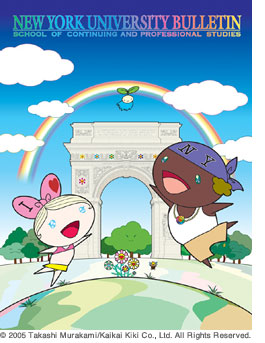
More info: NYU -SCPS's ANIMEted Summer
Pre-web anime fandom (Out of the Archives 4)
In the late 80's and early 90's, the internet was not yet widely available to the American public. Anime fans were already online, however, communicating with each other and sharing resources on services such as Prodigy, CompuServe, AOL, and GEnie. On a more local level, anime content could also be found on some BBSes, and there were even some anime-specific BBSes. Those who had access to the internet also shared material via Usenet, FTP, and Gopher. A lot of these became much less important after the World Wide Web took off in the mid-90's, but looking back, we can appreciate how they paved the way for today's vast information culture surrounding anime.
Here is a print ad from 1991 for the anime discussion boards found on GEnie.

Students of CJAS history should take note that one of the two sysops for the anime board was Richard Copeland, who (according to the ad) regularly attended CJAS (then known as CJS, the Cornell Japanimation Society). Lea Hernandez, the other sysop, was the vice president of General Products USA (the American merchandising division of Gainax) from 1989-1990.
One way that old school anime fans shared information with each other was through text files that were distributed across various bulletin boards. Anime Stuff, first published by Tom Mitchell in January of 1987, was one of the most well-known newsletters. Tom was a sysop of "The CompuServe Anime & Manga Forum". Starting with issue #5 (11/12/1987), none other than CJAS co-founder and first president Masaki Takai joined Tom in producing the newsletter. Masaki, then a freshman at Cornell, hadn't even started CJAS yet (the club was "born" on September 9th, 1988).
Issues (with associated images) of Anime Stuff are still available for download at the SUNET FTP archive's mirror of the much-loved but now-defunct Venice anime and manga FTP archive: Index of /pub/comics/anime-manga/anime.stuff
An even more accessible collection of Anime Stuff can be found here: Index of /OSA/PUBLICATIONS/anime-stuff courtesy of J!-ENT's Old School Anime website, which is a pretty fun read if you were a fan from that time, or if you're interested in that particular era of fandom.
Years before the CJAS newsletter was started in 1992, Masaki was already contributing heavily to Anime Stuff. Search the following index to find the articles he submitted: asindex6.pdf
Some readers might be interested in the interviews with Roe Adams and Masaki, in issues 17 and 20 respectively, where they talk about the early days of CJAS and the founding of Animeigo.
Related articles
Otaku no CJAS: Graffiti of the Otaku Generation 1988
10 Years of Decadence, CJAS-Style (another CJAS history article)

One way that old school anime fans shared information with each other was through text files that were distributed across various bulletin boards. Anime Stuff, first published by Tom Mitchell in January of 1987, was one of the most well-known newsletters. Tom was a sysop of "The CompuServe Anime & Manga Forum". Starting with issue #5 (11/12/1987), none other than CJAS co-founder and first president Masaki Takai joined Tom in producing the newsletter. Masaki, then a freshman at Cornell, hadn't even started CJAS yet (the club was "born" on September 9th, 1988).
Issues (with associated images) of Anime Stuff are still available for download at the SUNET FTP archive's mirror of the much-loved but now-defunct Venice anime and manga FTP archive: Index of /pub/comics/anime-manga/anime.stuff
An even more accessible collection of Anime Stuff can be found here: Index of /OSA/PUBLICATIONS/anime-stuff courtesy of J!-ENT's Old School Anime website, which is a pretty fun read if you were a fan from that time, or if you're interested in that particular era of fandom.
Years before the CJAS newsletter was started in 1992, Masaki was already contributing heavily to Anime Stuff. Search the following index to find the articles he submitted: asindex6.pdf
Some readers might be interested in the interviews with Roe Adams and Masaki, in issues 17 and 20 respectively, where they talk about the early days of CJAS and the founding of Animeigo.
Related articles
Otaku no CJAS: Graffiti of the Otaku Generation 1988
10 Years of Decadence, CJAS-Style (another CJAS history article)
Saturday, March 18, 2006
Maid in Akihabara : Episode 1 Review and Analysis
"What kind of place is this?" - Saki, upon entering the weird world of otaku
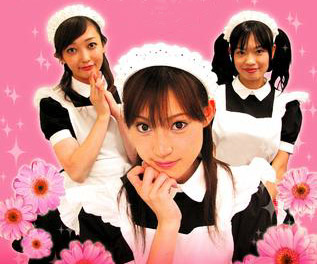 Last night, my wife and I watched and enjoyed the first 15-minute episode (out of six) of Maid in Akihabara (2005), a live-action Japanese comedy about a young woman, Saki, who becomes a server at a maid cafe in Akihabara, the world's most famous "geek ghetto", as the Washington Post puts it. Obviously, as a server in a maid cafe, she has to dress up as a maid, serving otaku customers looking for company and relaxation after, say, a long day of anime shopping or a night of waiting in line to score the perfect autograph to go on the perfect piece of anime/manga/game related merchandise. Needless to say, this world is completely foreign to Saki, but despite some initial discomfort, she tries to make the best of her situation.
Last night, my wife and I watched and enjoyed the first 15-minute episode (out of six) of Maid in Akihabara (2005), a live-action Japanese comedy about a young woman, Saki, who becomes a server at a maid cafe in Akihabara, the world's most famous "geek ghetto", as the Washington Post puts it. Obviously, as a server in a maid cafe, she has to dress up as a maid, serving otaku customers looking for company and relaxation after, say, a long day of anime shopping or a night of waiting in line to score the perfect autograph to go on the perfect piece of anime/manga/game related merchandise. Needless to say, this world is completely foreign to Saki, but despite some initial discomfort, she tries to make the best of her situation.If you're at all interested in Akihabara, otaku, and the curious phenomenon of maid/cosplay cafes, this comedy is for you. The idea of maid cafes might sound a bit distasteful to some, but if you've never been to one, what goes on inside might surprise you, which makes Maid in Akihabara worth watching. Just keep in mind that the show exaggerates many things in order to entertain the audience, but like all good comedies, those exaggerations are based on elements of truth. Another thing to keep in mind is that not all (or even most) otaku visit maid cafes. Works of fiction and news agencies alike, trying to present simple and coherent stories, often neglect to mention the diversity of otaku culture, which is actually quite complex. Also, for the sake of this review, when I refer to otaku, I'm talking primarily about male (and heterosexual) otaku, even though female otaku certainly exist.
I've never been to a maid cafe myself, but the descriptions I've heard and read of them seem to match (at least vaguely) what I saw in the comedy. Besides the typically fun portrayals of otaku interacting with each other in their natural habitat (something that I personally relate to), the show also gets into the fascinating interactions between the otaku and the maids who are serving them.
Some might find those interactions creepy, but I found them to be surprisingly sensitive. Even though the maids acted out submissive roles, they maintained strong boundaries over what was acceptable and always sought to maintain control of the situation. Except for some nervous ogling, and the very basic fact that the maids were dressed for their benefit, the otaku treated the maids with an enormous amount of respect and courteousness, as if they were celebrities. The otaku didn't boss them around, make inappropriate advances toward them, or otherwise act misogynistically. Their general vibe was one of immense gratefulness. Instead of pretending to be Casanovas--bragging about sexual conquests and the ability to seduce women--the otaku were honest about their inexperience with the opposite sex.
Maid Cafes and Otaku Sexuality
If we consider maid cafes to be sexist, it's because of the role otaku prefer for the women--clearly subservient, completely unthreatening, unswervingly adoring, unconditionally faithful, and pure of both mind and body. Undoubtedly, the maids at these cafes represent an antiquated ideal of womanhood. This phenomenon is not new. Strip clubs and bars where the waitresses have to dress up in bunny outfits both feature women who serve at the pleasure of male clientele. Some people who complain about such places will say that those establishments are reflections/manifestations of male-dominated society. Yet, while Japan certainly has its share of gender inequality, I would be very shocked to hear that otaku who frequent maid cafes are at all dominant over women in real life (except for the extreme minority who become involved in sex crimes). For most otaku, the interactions they have with women at maid cafes are a complete fantasy.
The real question, left unanswered by the show, is how the otaku patrons of maid cafes feel about real women, what their expectations are of the opposite sex outside of the maid fantasy world. Are these cafe visits brief moments of escapist fantasy, or do they represent (or at least influence) Japanese otaku's broader worldviews about women in general? The common perception is that male otaku in Japan don't (and often don't want to) interact intimately with women very much, especially if the women are not otaku themselves. (See the troubled hero of Densha Otoko for an example of an otaku who struggles to do just that.)
Is such lack and difficulty of interaction exacerbated by these maid fantasies? Does being a fan of moe hurt one's prospects of having healthy relationships with real women? I don't actively study otaku in Japan, so I won't draw any conclusions about that, but I'm going to safely guess that the answer is not black and white. Being into moe, or pornography for that matter (itself mostly fantasy), can be unhealthy if taken to certain extremes, but I don't think it has to be, and it probably isn't unhealthy most of the time for most people.
Most of the American otaku I've met (males and females, fans of moe included) are pretty well-balanced individuals who are able to interact well with each other and non-otaku. The influx of female and younger fans has resulted in a different kind of socialization, compared (for example) to American anime fandom 10 years ago, and I think the effect has been positive overall. Today, a diverse mix of people in America are proud to call themselves otaku.
Related links
'Maid in Japan' cafes treat geeks like lords One of many articles describing the maid cafe phenomenon
New Butler Cafe to Cater to Otaku Girls Female otaku looking for some pampering are not left out
Original Video / Maid in Akihabara DVD (released on 2/24/06) available at cdjapan; site includes cast information
A note on the references in the show
When the otaku are talking in the cafe, they routinely refer to real life shows. I'm not an expert on all the references, but I do recognize some of the more obvious ones, like Mobile Suit Gundam quotes. One reference I wanted to bring up, however, is the discussion the two otaku had about Ultra Seven (1967-1968) episode 12.
 I definitely am not an expert on tokusatsu, but I have read about the "banned" 12th episode of Ultra Seven. To make a long story short, other than the original broadcast, the episode was never again broadcast or released in Japan, and no mention of the episode is ever made in any of the official reference books for the show. Due to a controversy over the naming of one of the monsters (it sounded too much like the name given to survivors of the Hiroshima and Nagasaki bombings), the studio promised to seal the episode away forever (though the English dub of the episode has been broadcast a few times outside of Japan).
I definitely am not an expert on tokusatsu, but I have read about the "banned" 12th episode of Ultra Seven. To make a long story short, other than the original broadcast, the episode was never again broadcast or released in Japan, and no mention of the episode is ever made in any of the official reference books for the show. Due to a controversy over the naming of one of the monsters (it sounded too much like the name given to survivors of the Hiroshima and Nagasaki bombings), the studio promised to seal the episode away forever (though the English dub of the episode has been broadcast a few times outside of Japan).Even more interesting is the fact that Tsutomu Miyazaki, the man whose heinous crimes caused Japan's mainstream media to incite widespread fear and hatred of otaku, had a copy of this banned episode (see the second link below). I've also read that he used his bootleg copy as a valuable bargaining chip to obtain other (oftentimes illicit) material. [Unfortunately, I've lost my source for that second bit of information, so if you know anything about it, please let me know.] By referencing this rare Ultra Seven episode, the writers of Maid in Akihabara are showing us that otaku know about things that normal 'civilians' do not, and maybe the writers are also indirectly evoking the memory of Miyazaki's crimes.
Related links
The Banned Ultraseven Episode Informative Usenet posting
ULTRA SEVEN: BANNED! Scroll down on that page to see the article
Thursday, March 16, 2006
SNK brochures 1996 (Out of the Archives 3)
In the summer of 1996, I sent a letter to the American branch of SNK asking for information and promotional material for an article I was planning to write for the CJAS Newsletter. The company kindly sent me back a large folder/brochure that included game flyers and catalogs.
I've seen some of the same flyers and catalogs online at The Arcade Flyer Archive, a truly magnificent resource for those who fondly look back at the glory days of video arcades in America, Asia, and elsewhere.
I have scanned the flyers and catalog that I didn't see on that archive, as well as the folder/brochure they came in [the scanner bed was smaller than the folder, so some of the images are slightly cut off]. I hope to submit these images to that site.

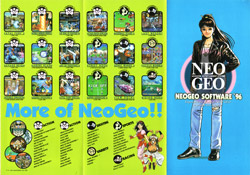


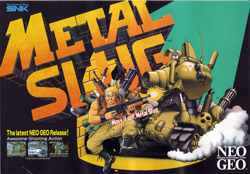

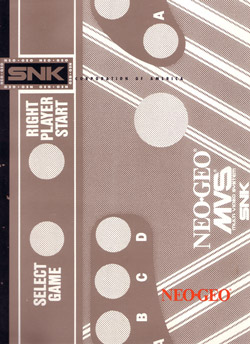


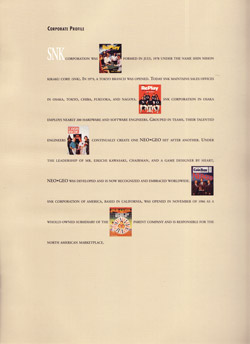


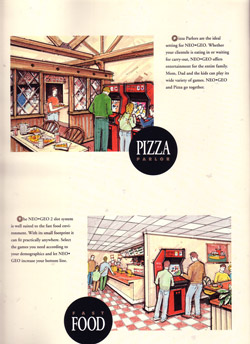

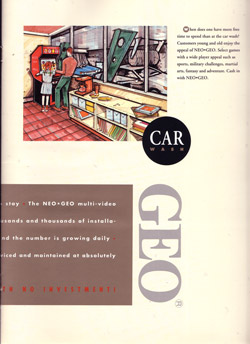

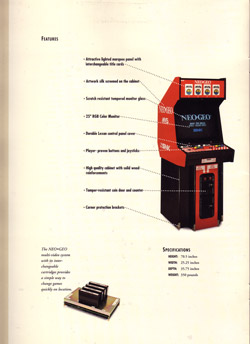

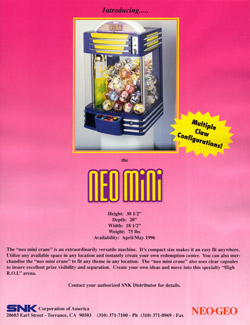
Speaking of old software publications, I recently read about Jason Scott's project of scanning in old computer ads, brochures, flyers, etc. Scott also produced a highly acclaimed documentary about the BBS scene. I got into BBSes pretty late, but in Korea in 1993, English-language BBSes were the closest thing a kid like me had to the internet (by 1994, I was using the internet at Cornell).
All of this scanning, archiving, and documentation of geek history reminds me of what William Gibson said:
We are all curators, in the post-modern world, whether we want to be or not.
I've seen some of the same flyers and catalogs online at The Arcade Flyer Archive, a truly magnificent resource for those who fondly look back at the glory days of video arcades in America, Asia, and elsewhere.
I have scanned the flyers and catalog that I didn't see on that archive, as well as the folder/brochure they came in [the scanner bed was smaller than the folder, so some of the images are slightly cut off]. I hope to submit these images to that site.



















Speaking of old software publications, I recently read about Jason Scott's project of scanning in old computer ads, brochures, flyers, etc. Scott also produced a highly acclaimed documentary about the BBS scene. I got into BBSes pretty late, but in Korea in 1993, English-language BBSes were the closest thing a kid like me had to the internet (by 1994, I was using the internet at Cornell).
All of this scanning, archiving, and documentation of geek history reminds me of what William Gibson said:
Monday, March 13, 2006
Their Finest Hour (Out of the Archives 2)
Here is one of my favorite print ads ever, for sentimental reasons certainly, though I think it was well done in general.
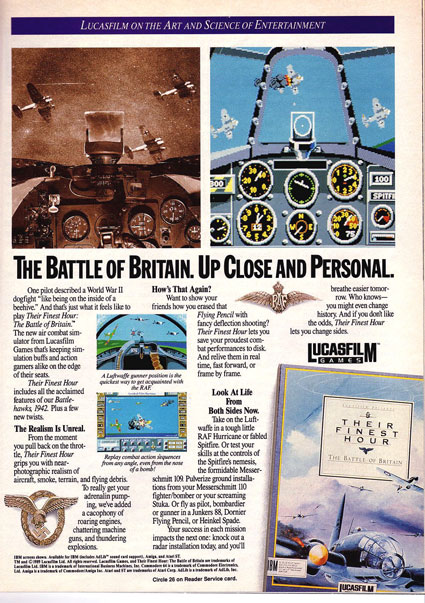
click on image for larger version
This is an ad (scanned from an old issue of Computer Gaming World) for Their Finest Hour: The Battle of Britain (1989), published by LucasFilm Games. Second in the trilogy of action-oriented WWII flying games developed by Lawrence Holland, Their Finest Hour is considered by some publications to be one of the best computer games of all time. Holland, who I recently discovered is a Cornell alumnus, went on to create the enormously successful X-Wing series of games, which I also enjoyed. More recently, I had fun finishing Secret Weapons Over Normandy on the PS2, which is similar to the third game in the original trilogy--Secret Weapons of the Luftwaffe (1991).
When my dad brought home our first computer (an AST 386SX-16) in the late 80s, the first two games I had on it were Strike Fleet (1987) and Battlehawks 1942 (the first game of the trilogy). Strike Fleet, a very early RTS game, was okay, but Battlehawks 1942 (1988) was an all-consuming experience, totally brilliant in its execution. It came with a huge manual that went into the entire history of the Pacific Air War and the intricacies of that era's aerial combat. Even then, it was obvious that LucasFilm games ought to use the same game engine or something similar to create a Star Wars game, but that wouldn't happen until many years later.
When Their Finest Hour was announced, I was (predictably) psyched. I think I was excited at the prospect of being able to fly a Supermarine Spitfire, my favorite WWII fighter plane. Plus, the ad promised amazing new features and a new level of realism never before seen in combat flight sims. Compelling layout and use of images (in the ad) didn't hurt, either.
As a kid, I would look at the above ad over and over again, and when I finally got the game, it definitely lived up to my expectations, providing mant hours of entertainment (and education, for that matter). In addition to the ad, I still have the original box, discs, and manual (which was amazing).
Related links:
Their Finest Hour : Battle of Britain (information and screenshots)
Their Finest Hour: Lucasfilm Games Launches The Battle of Britain (original review from 1990)

click on image for larger version
This is an ad (scanned from an old issue of Computer Gaming World) for Their Finest Hour: The Battle of Britain (1989), published by LucasFilm Games. Second in the trilogy of action-oriented WWII flying games developed by Lawrence Holland, Their Finest Hour is considered by some publications to be one of the best computer games of all time. Holland, who I recently discovered is a Cornell alumnus, went on to create the enormously successful X-Wing series of games, which I also enjoyed. More recently, I had fun finishing Secret Weapons Over Normandy on the PS2, which is similar to the third game in the original trilogy--Secret Weapons of the Luftwaffe (1991).
When my dad brought home our first computer (an AST 386SX-16) in the late 80s, the first two games I had on it were Strike Fleet (1987) and Battlehawks 1942 (the first game of the trilogy). Strike Fleet, a very early RTS game, was okay, but Battlehawks 1942 (1988) was an all-consuming experience, totally brilliant in its execution. It came with a huge manual that went into the entire history of the Pacific Air War and the intricacies of that era's aerial combat. Even then, it was obvious that LucasFilm games ought to use the same game engine or something similar to create a Star Wars game, but that wouldn't happen until many years later.
When Their Finest Hour was announced, I was (predictably) psyched. I think I was excited at the prospect of being able to fly a Supermarine Spitfire, my favorite WWII fighter plane. Plus, the ad promised amazing new features and a new level of realism never before seen in combat flight sims. Compelling layout and use of images (in the ad) didn't hurt, either.
As a kid, I would look at the above ad over and over again, and when I finally got the game, it definitely lived up to my expectations, providing mant hours of entertainment (and education, for that matter). In addition to the ad, I still have the original box, discs, and manual (which was amazing).
Related links:
Their Finest Hour : Battle of Britain (information and screenshots)
Their Finest Hour: Lucasfilm Games Launches The Battle of Britain (original review from 1990)
Seiko Frequency Watch (Out of the Archives 1)
I am somewhat of a packrat. I collect different things, including stuff found on the internet, much of which is no longer available. In this "Out of the Archives" series, I'll be posting some random old stuff that deserves (in my opinion) the light of day, since it's just getting dusty sitting on my hard drive.
Recently, there has been discussion regarding the following article about the "Top 10 Geek Watches": http://www.productdose.com/2006/03/07/top-10-geek-watches/
I'm all for celebrating geek culture, but I didn't particularly like any of the watches listed in that article, but that's not the point. I wanted to mention one particularly geeky watch that was not listed--the Seiko Frequency Watch, released in the late 90's. In short, it's a drum machine watch intended for DJs, people at raves or dance clubs, and musicians. See the related links at the end of this post if you want to learn more about it.
There are several websites that talk about this watch, including a few in Japanese. The sites in English neglect to mention that the watch was made in collaboration with Tetsuya "TK" Komuro, the J-pop megastar most famous in the 90's and one of the pioneers of electronic dance music in Japan. See my previous article for more information on TK.
Here are some official images I saved in 1999. That's TK in the first image. The last image appears to be the Globe version of the same watch. (Globe is one of TK's bands)




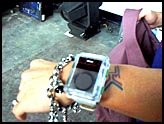
For the record, I usually wear an Omega Seamaster given to me by my wife, or a titanium Swiss Army watch given to me by my dad. The watch I would eventually love to own (if I could ever afford it) is a custom-made Triomphe made by Allen Elishewitz who is most famous for his beautiful knife designs.
Related links:
Seiko's drum machine wristwatch
The Seiko Drum Machine
SEIKO Frequency
SEIKO Frequency globe MODEL II
Friday, March 10, 2006
Infornographic Design
Some Thoughts on Packaging and Retail Spaces
 Floating around on the web these past few weeks was a parody video asking what it would be like if Microsoft designed the packaging for the Apple iPod. The clip was amusing, but one thing that struck me is that I don't really like Apple packaging that much, and that (real) Microsoft packaging doesn't overly offend me. Now, even though I use antiquated machines running Windows, I do consider myself a fan of Apple and its history (especially the time period just as Steve Jobs returned to the company and began turning things around), though I've been skeptical of some of the more recent offerings.
Floating around on the web these past few weeks was a parody video asking what it would be like if Microsoft designed the packaging for the Apple iPod. The clip was amusing, but one thing that struck me is that I don't really like Apple packaging that much, and that (real) Microsoft packaging doesn't overly offend me. Now, even though I use antiquated machines running Windows, I do consider myself a fan of Apple and its history (especially the time period just as Steve Jobs returned to the company and began turning things around), though I've been skeptical of some of the more recent offerings.But anyway, back to packaging. Apple products are often described as sexy, but why should one company get to decide for everyone what is sexy? I understand the appeal of simplicity in design, but I also have a personality that really likes information density.
 While it's true that Apple products come in distinctive and eye-catching boxes, their simplicity gives them an artistic appeal that is very different from the geek/otaku aesthetic that I'm used to and have grown to prefer.
While it's true that Apple products come in distinctive and eye-catching boxes, their simplicity gives them an artistic appeal that is very different from the geek/otaku aesthetic that I'm used to and have grown to prefer.Some have described otakuism as a form of information fetishism, and with that in mind, Apple packages just don't do it for me. I don't love Microsoft software, but I do like some of Microsoft's box designs. I am also a fan of devices made by Logitech and Creative, and enjoy their packaging as well. When it comes to electronics, I feel that at least one side of the package should be full of informative text and images that require a certain level of technical/media/cultural literacy to fully understand and appreciate. It's not enough that I can find the information elsewhere (like on the web). I like hardware packaging to look good and tell me a lot.

Logitech MX1000 (image courtesy of kennysia.com)
Another review with more images can be found here.
Where does this preference come from? As a kid, I would often choose my breakfast cereal based on which box was the most fun to read and look at (far more important to me than whatever prize was inside). I like potato chip bags and restaurant menus that tell the me the story behind the company. When watching anime fansubs, I like text all over the screen (sign translations, notes on content, song lyrics and translations). I don't buy DVDs unless they come with extensive extras (and throw in some dense liner notes while you're at it).
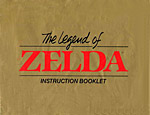 Video games should have manuals that are fun and interesting to read cover-to-cover, not just skimmed once and then tossed aside. I'm not saying that Apple necessarily prefers style over substance when it comes to package design. I'm just saying that information density is its own style, albeit intended for a different target audience--people who have deeply internalized the concept of infornography. Quoting my own website (about the serial experiments lain anime):
Video games should have manuals that are fun and interesting to read cover-to-cover, not just skimmed once and then tossed aside. I'm not saying that Apple necessarily prefers style over substance when it comes to package design. I'm just saying that information density is its own style, albeit intended for a different target audience--people who have deeply internalized the concept of infornography. Quoting my own website (about the serial experiments lain anime):"Infornography" seems to be a made up word combining information and pornography, the idea being that ... information is being considered not just a valuable commodity from a practical point of view, but something that generates an almost sexual thrill, something that we lust after and enjoy hunting because it is special and gives us power.Infornographically designed things have a visceral appeal1 of their own, even if it's not for everyone (or maybe even most people).
 We can look at retail spaces in the same way. Whenever I'm at the mall, I make it a point to visit The Apple Store to look and play with the various products, even though I'm not a big fan of the store's look and feel. When Apple stores first opened, they were exciting places, but I find them pretty boring these days. For the most part, they all look about the same inside. Like McDonald's, there are no surprises--you always know what to expect. When all is said and done, there's not really that much to look at (in my opinion, they ought to have videos running in their theater constantly). It's all the same stuff, and there's no thrill of the hunt. As someone who likes to spend hours in used bookstores, Apple stores are too sterile and deliberately constructed for my tastes.
We can look at retail spaces in the same way. Whenever I'm at the mall, I make it a point to visit The Apple Store to look and play with the various products, even though I'm not a big fan of the store's look and feel. When Apple stores first opened, they were exciting places, but I find them pretty boring these days. For the most part, they all look about the same inside. Like McDonald's, there are no surprises--you always know what to expect. When all is said and done, there's not really that much to look at (in my opinion, they ought to have videos running in their theater constantly). It's all the same stuff, and there's no thrill of the hunt. As someone who likes to spend hours in used bookstores, Apple stores are too sterile and deliberately constructed for my tastes.For computer stuff, I prefer Fry's Electronics, but if you want to talk about my all time favorite shopping spaces, nothing beats Japan. Akihabara is great, of course, but I like the Nakano Broadway even better. Inside, it has floor after floor of different Mandarake (and other) stores selling anime and manga merchandise, and none of them are the same. Each store has a different speciality, and each is packed to the gills with unique and often rare merchandise, difficult to find even within the store. I spent almost a whole day wandering around in there, and I could have spent several more. It was paradise.

Akihabara at night (photo courtesy of Eddie Chen)

Rare and ultra expensive artbooks for sale at one of the Mandarake stores in the Nakano Broadway
I haven't been to Nipponbashi yet, but I hear that is another excellent otaku shopping destination. For now, anime convention dealers' rooms in the US are the next best thing--chaotic, dense, full of uninteresting stuff, but containing some hidden gems as well.
 Maybe I'm just biased against things that have clearly prescribed meanings. The iPod and chain stores in normal American shopping malls can get away with a certain amount of minimalism and repetitiveness when it comes to presenting information because everyone knows the iPod, The Apple Store, The Gap, Macy's, etc.--what they stand for, what they symbolize. These are American and global icons, brands that have seared themselves into our consciousness so that we don't need to read or think about them anymore when making purchase decisions.
Maybe I'm just biased against things that have clearly prescribed meanings. The iPod and chain stores in normal American shopping malls can get away with a certain amount of minimalism and repetitiveness when it comes to presenting information because everyone knows the iPod, The Apple Store, The Gap, Macy's, etc.--what they stand for, what they symbolize. These are American and global icons, brands that have seared themselves into our consciousness so that we don't need to read or think about them anymore when making purchase decisions.Something about these uber-powerful brands bothers me a little. It probably has to do with the fact that I do like to read and think before I buy things, and too many voices are all around telling me that I don't have to, that the right choices are obvious. On the contrary, I think the right choices are far from obvious, and are contingent upon a wide range of local and personal factors. Furthermore, if our choices were obvious, they wouldn't be any fun.
Related reading:
Visceral design: do looks matter? the same subject discussed on Presentation Zen
Meet the Apple Pack Rats an article about Apple packaging and the people who love it
Package Development at Microsoft: How XBOX Broke Out of the Box
Revisiting the City Electric an article on Akihabara
Nakano Broadway
Den Den Town an article on Nipponbashi and retro gaming
AnimeCons.com Find anime conventions in your area
Subscribe to:
Posts (Atom)